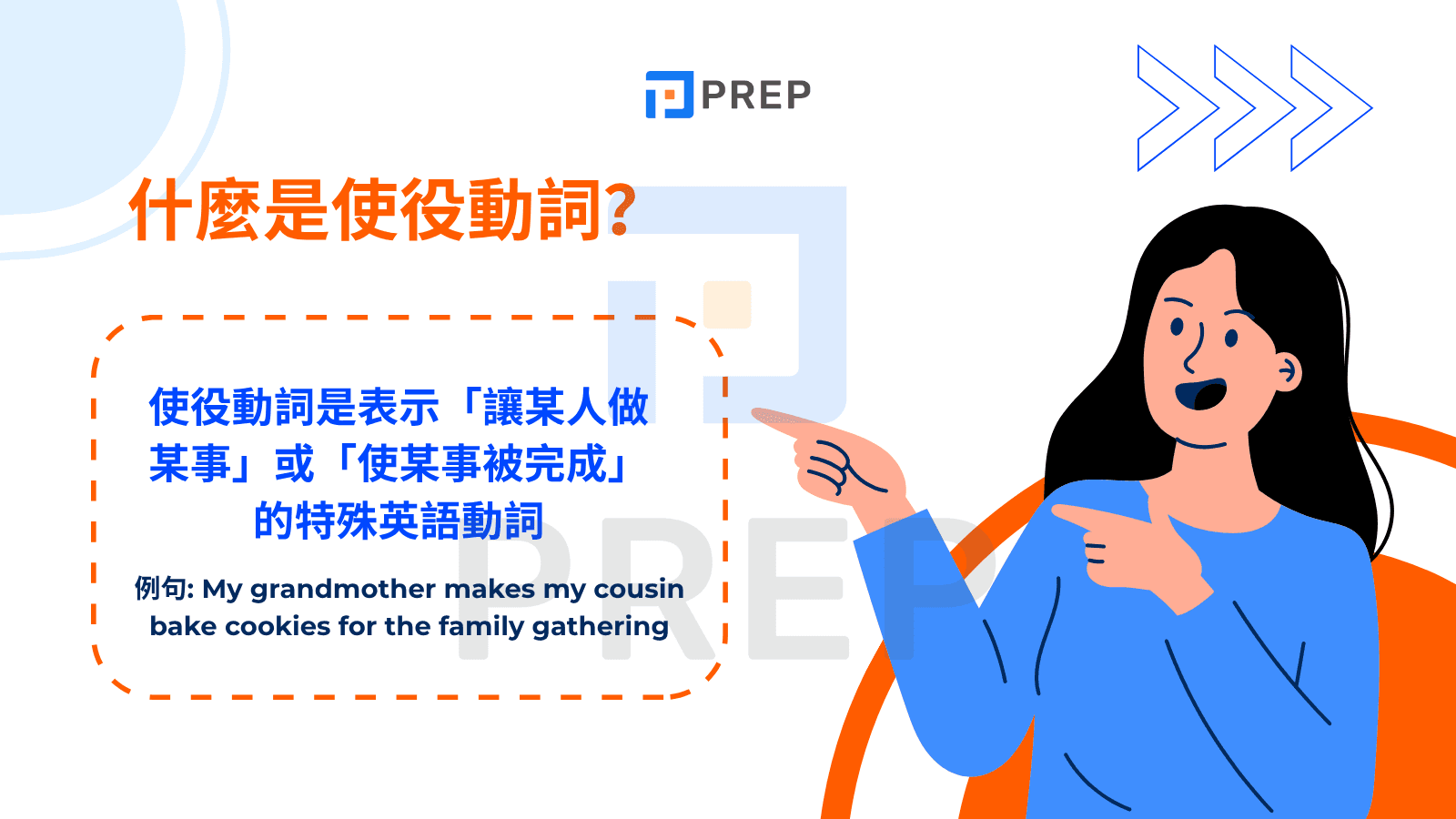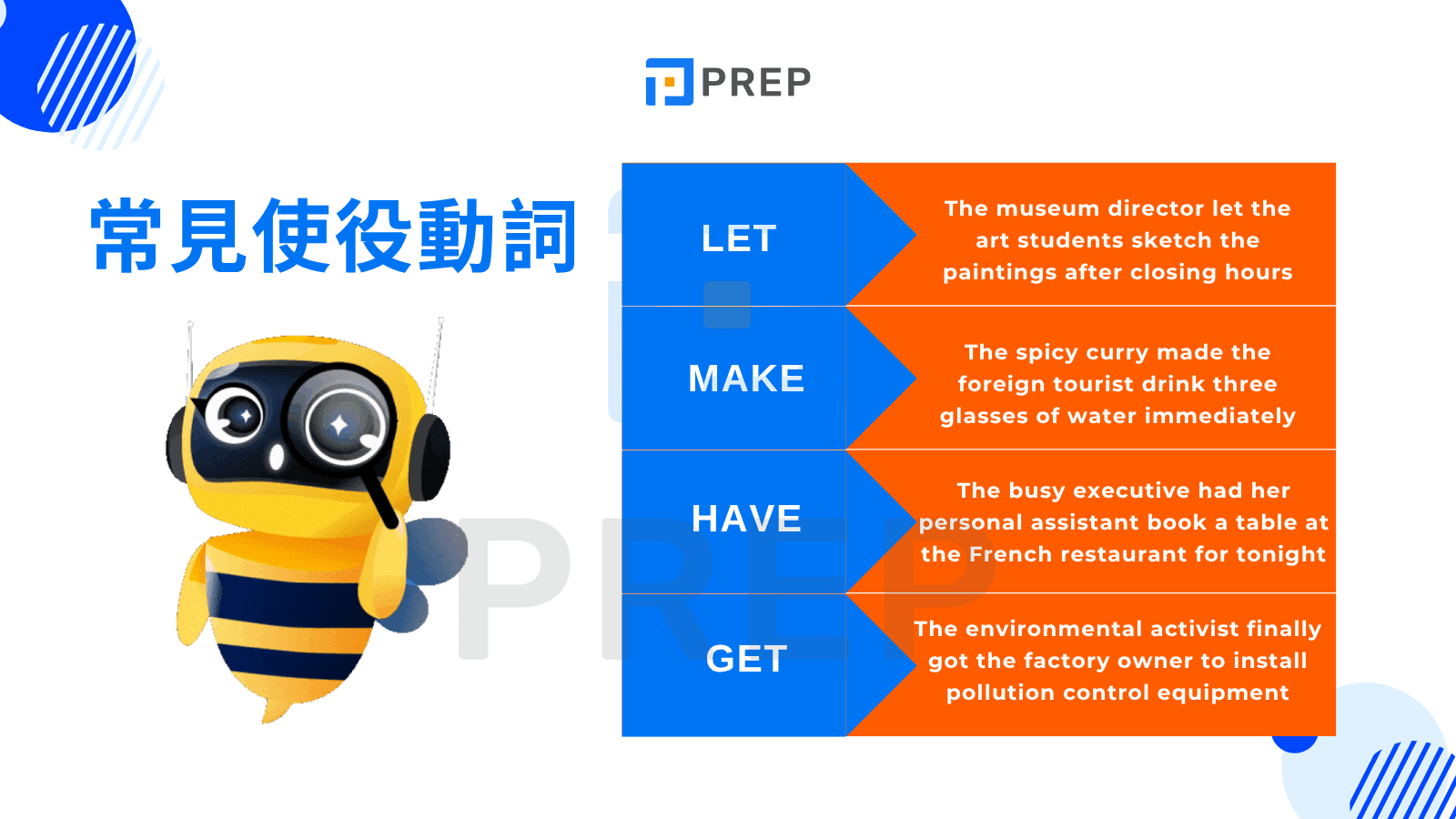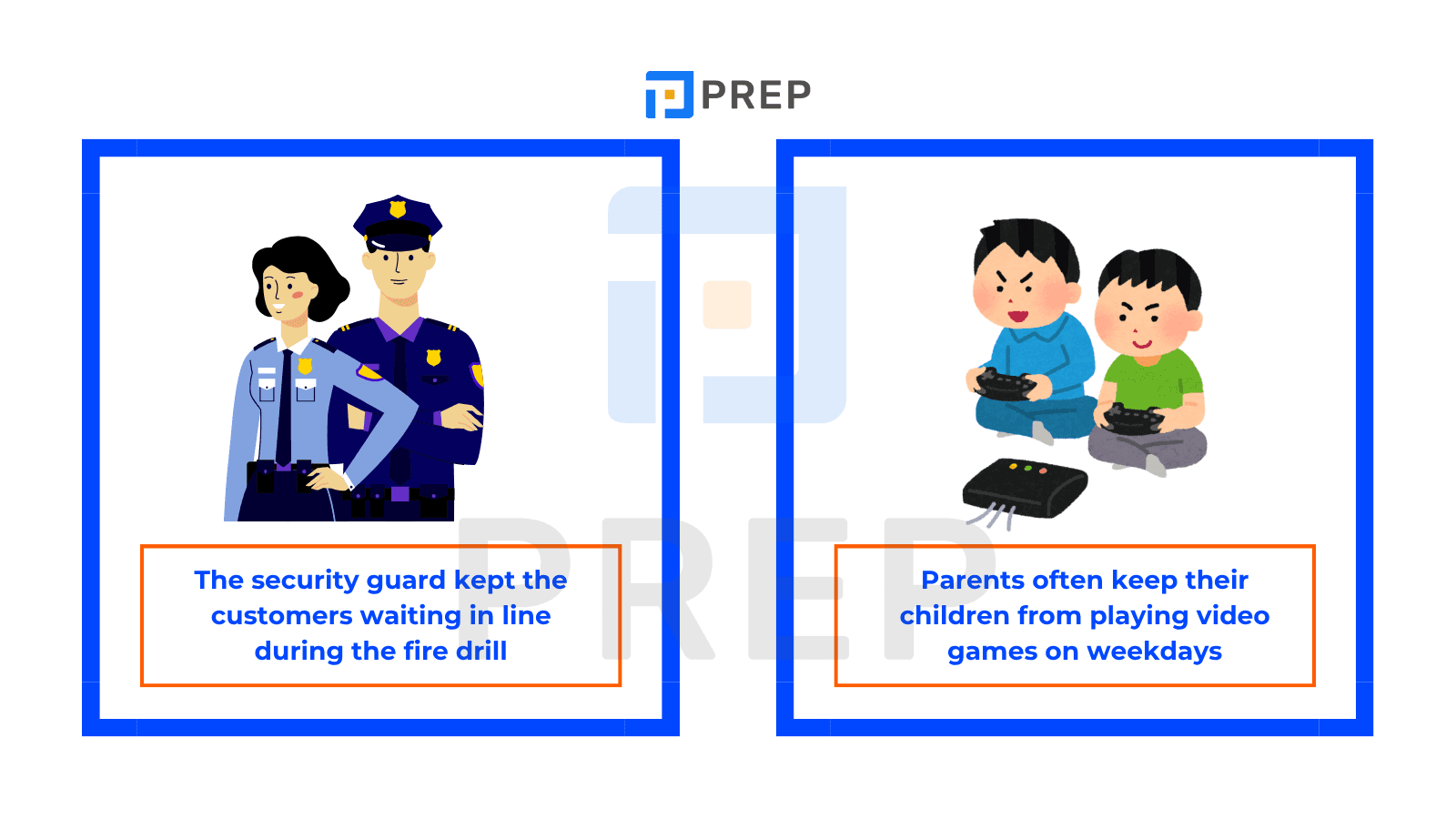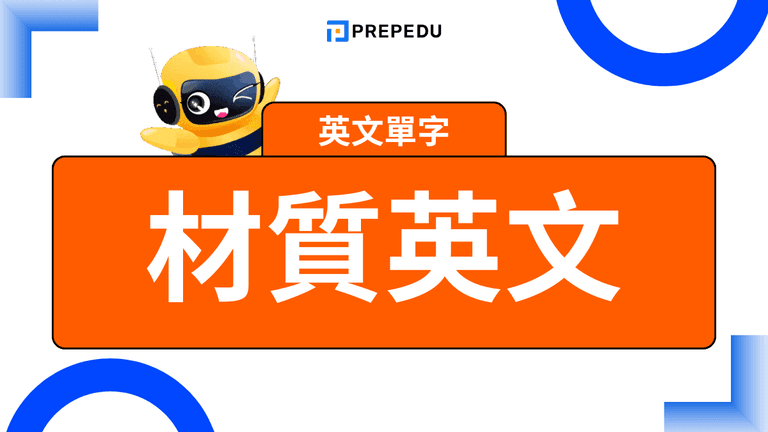【英文使役動詞最完整指南】10大動詞make let have get allow permit等用法與主被動差異
在PREP多年的英文教學經驗中,我們發現使役動詞是最讓學習者感到困惑的文法重點之一,尤其是10大常用動詞的語氣強度與句型差異。本文將深入解析英文使役動詞用法,完整涵蓋所有causative verbs核心概念。
使役動詞英文學習的複雜性在於其豐富的語意層次和嚴格的文法規則。從基礎的make、let、have、get,到進階的allow、permit、force、require、keep、help,每個動詞都有獨特的語氣強度和適用場景。使役動詞有哪些特殊規則?使役動詞後面加什麼形式的動詞?這些問題涉及主動與使役動詞被動語態的精細區別。許多學習者在面對「allow to do」與「let do」、「force to work」與「make work」時常感困惑,不知道何時需要加「to」,何時省略。
PREPEDU.COM將透過系統化教學,從語氣分析到句型拆解,讓您完全掌握這10大使役動詞的正確用法,並提供豐富例句和實戰練習,確保學習成效最大化。現在就開始掌握完整的使役動詞體系吧!

I. 什麼是使役動詞?
使役動詞(Causative Verbs)是指能夠表達「使某人做某事」或「讓某事被完成」概念的特殊英語動詞。這類動詞的核心功能在於描述主詞透過某種方式影響或促使受詞執行特定動作,而非主詞直接進行該動作。使役動詞與一般英語動詞在句型結構上存在幾個關鍵差異:
-
語法結構:使役動詞需要雙受詞結構(直接受詞 + 動作受詞),而一般動詞通常只需單一受詞
-
動作執行者:使役動詞句中的真正動作執行者是受詞,而非主詞
-
後接動詞形式:使役動詞後的動詞必須遵循特定規則,不能隨意變化時態
許多學習者容易將使役動詞與感官動詞混淆。例如:
-
The security guard saw the teenager spray graffiti on the wall.(保全看見青少年在牆上噴塗鴉。)→ spray 使用原形動詞表示完整動作
-
The security guard saw the teenager spraying graffiti on the wall.(保全看見青少年正在牆上噴塗鴉。)→ spraying 則表示進行中的動作
讓我們看更多實際例句來理解這種差異:
-
一般動詞:My grandmother bakes cookies every Sunday.(我祖母每個星期天烤餅乾。)
-
使役動詞:My grandmother makes my cousin bake cookies for the family gathering.(我祖母讓我表弟為家族聚會烤餅乾。)
在第一個例句中,祖母親自烤餅乾;在第二個例句中,祖母讓表弟去烤餅乾。這種細微差別正是掌握英文使役動詞用法的關鍵所在。

II. 使役動詞有哪些?
英文中最常用的使役動詞有哪些?以下是完整的使役動詞清單:
|
使役動詞 |
中文意思 |
例句 |
|
Let /lɛt/ |
讓、允許(表示允許或許可) |
The museum director let the art students sketch the paintings after closing hours.(博物館館長讓藝術系學生在閉館後素描畫作。) |
|
Make /meɪk/ |
使、讓(表示強制或必然結果) |
The spicy curry made the foreign tourist drink three glasses of water immediately.(辛辣的咖哩讓外國觀光客立刻喝了三杯水。) |
|
Have /hæv/ |
請、讓(表示安排或委託) |
The busy executive had her personal assistant book a table at the French restaurant for tonight.(忙碌的主管讓私人助理為今晚在法式餐廳訂位。) |
|
Get /ɡɛt/ |
讓、使(表示說服或達成) |
The environmental activist finally got the factory owner to install pollution control equipment.(環保運動人士終於讓工廠老闆安裝污染控制設備。) |
|
Help /hɛlp/ |
幫助(表示協助完成) |
The experienced mountaineer helped the novice climber reach the summit safely.(經驗豐富的登山者幫助新手攀登者安全到達山頂。) |
|
Allow /əˈlaʊ/ |
允許、容許(表示官方或條件性的許可) |
The teacher allowed the students to use calculators during the final exam.(老師允許學生在期末考試中使用計算機。) |
|
Permit /pɚˈmɪt/ |
准許、允許(較正式) |
The city government permitted street performers to play music in the plaza on weekends.(市政府准許街頭藝人在週末於廣場演奏音樂。) |
|
Force /fɔːrs/ |
強迫、逼使(表示外力或壓力) |
The bad weather forced the hikers to turn back before reaching the top.(惡劣天氣迫使登山客在抵達山頂前就折返。) |
|
Require /rɪˈkwaɪr/ |
要求、規定(常用於制度或規則) |
The airline requires all passengers to wear seat belts during takeoff and landing.(航空公司規定所有乘客在起飛和降落時必須繫上安全帶。) |
|
Keep /kiːp/ |
使保持、讓持續(使某行動持續進行) |
The coach kept the team practicing until they perfected the new routine.(教練讓隊伍持續練習直到完美掌握新動作。) |
這些使役動詞英文各自具有不同的語氣強度和使用場景,是構成完整使役動詞體系的核心元素。

III. 使役動詞核心句型與用法拆解
使役動詞的文法結構主要分為兩種基本句型,這兩種句型決定了使役動詞後面加什麼形式的動詞。理解這些核心句型是掌握使役動詞用法的基礎。
1. 句型一:接原形動詞(主動語態)
主動語態的使役動詞句型表示受詞主動執行動作,其基本結構為:
主詞 + 使役動詞 + 受詞 + 原形動詞
在此句型中,受詞是動作的執行者,動作以主動方式進行:
-
Let 的用法:She let her children play in the garden.(她讓孩子們在花園裡玩耍。)
-
Make 的用法:The teacher made the students rewrite their essays.(老師讓學生重寫他們的作文。)
-
Have 的用法:I had my assistant prepare the documents.(我讓助理準備文件。)
2. 句型二:接過去分詞(被動語態)
使役動詞被動語態表示受詞被動接受動作,其基本結構為:
主詞 + 使役動詞 + 受詞 + 過去分詞
此句型強調受詞是動作的承受者,動作由他人執行:
-
Have 的被動用法:I had my car washed yesterday.(我昨天讓人洗了車。)
-
Get 的被動用法:She got her hair cut at the new salon.(她在新沙龍剪了頭髮。)
-
Allow 的被動用法:The manager allowed the documents to be printed before the meeting.(經理允許這些文件在會議前被列印出來。)
IV. 各使役動詞語意與使用場景解析
1. Let / Allow / Permit:表示允許與許可
文法公式:
Let + 受詞 + 原形動詞
Allow + 受詞 + to V
Permit + 受詞 + to V
這三個動詞皆表示允許某人做某事,不同之處在於語氣正式程度與語法結構上的差異:
|
使役動詞 |
語氣特點 |
常見使用情境 |
例句 |
|
Let |
口語、友善、非正式 |
朋友、父母對孩子、日常對話 |
The hotel manager let the young couple check in early for their honeymoon suite.(飯店經理讓這對年輕夫婦提早入住蜜月套房。) |
|
Allow |
中性、略正式、較客觀 |
教學、公司規範、學術、正式請求 |
The teacher allowed the students to use calculators during the exam.(老師允許學生在考試中使用計算機。) |
|
Permit |
書面、正式、帶規範意味 |
政府、機構規定、公文、規章 |
The museum permits photography only in designated areas.(博物館僅在指定區域允許拍照。) |
2. Make / Force / Require:表示強制與必然
文法公式:
Make + 受詞 + 原形動詞
Force + 受詞 + to V
Require + 受詞 + to V
這三個動詞皆表示強制某人做某事,但語氣強弱與適用情境略有不同:
|
使役動詞 |
語氣特點 |
常見使用情境 |
例句 |
|
Make |
最強烈、帶有壓力或不可避免的結果 |
命令、自然反應、課業壓力 |
The professor's challenging assignment made the graduate students spend entire weekends in the library.(教授富有挑戰性的作業讓研究生整個週末都待在圖書館。) |
|
Force |
更具強迫性,通常對方不願意 |
惡劣天氣、環境壓力、他人強迫 |
The heavy rain forced the hikers to cancel their trip to Yangmingshan.(大雨迫使登山客取消他們的陽明山行程。) |
|
Require |
最正式、帶有制度與規範性 |
法律、公文、工作政策、官方要求 |
The new immigration law requires all visitors to submit a digital health declaration.(新的移民法規定所有訪客都需提交數位健康申報。) |
3. Have:表示安排與委託
文法公式:
主動:Have + 受詞 + 原形動詞
被動:Have + 受詞 + 過去分詞
Have 作為使役動詞時,通常表示安排他人代為執行任務,或委託專業人士提供服務。這個用法在日常生活中極為常見。
-
語氣特點:委託、安排、服務導向
-
使用場景:委託專業服務、安排他人代勞
典型例句:
-
The celebrity had her stylist choose the perfect gown for the movie premiere.(這位名人讓造型師為電影首映會挑選完美的禮服。)
-
We had the interior designer renovate our living room before the housewarming party.(我們讓室內設計師在喬遷派對前翻新客廳。)
4. Get:表示說服與達成
文法公式:
主動:Get + 受詞 + to + 原形動詞
被動:Get + 受詞 + 過去分詞
Get 作為使役動詞具有雙重功能,既可表示透過說服達成目標,也可用於被動語態表示安排服務。
-
語氣特點:說服、努力達成、結果導向
-
使用場景:說服他人、安排服務、達成目標
典型例句:
-
The sales manager got his reluctant team to work overtime during the holiday season.(銷售經理說服不情願的團隊在假期季節加班。)
-
I finally got my vintage motorcycle repaired at the specialized garage downtown.(我終於在市中心的專業車庫修好了我的古董機車。)
5. Help:表示協助與支持
文法公式:
Help + 受詞 + 原形動詞 / to V(兩者皆可接受)
Help 在使役動詞中語氣最溫和,表示協助他人完成某動作。它可視語境使用「to + V」或省略 to,語法彈性高。
-
語氣特點: 協助、鼓勵、支援
-
使用場景: 教學互動、職場協助、人際支持
典型例句:
-
The coach helped the swimmer improve her breathing technique before the competition.(教練在比賽前幫助游泳選手改進呼吸技巧。)
-
My brother helped me (to) fix the flat tire on the scooter.(我哥哥幫我修好了機車的爆胎。)
6. Keep:表示持續性與限制
文法公式:
Keep + 受詞 + 現在分詞 (V-ing)
雖然 Keep 並非典型的 使役動詞有哪些 成員之一,但在功能上,它也可表達「讓某事持續發生」,屬於廣義的 使役動詞用法 應用。其結構與其他 causative verbs 不同,後面接 V-ing 而非原形動詞或 to V。
典型例句:
-
The security guard kept the customers waiting in line during the fire drill.(消防演練期間保全讓顧客在排隊區等待。)
-
Parents often keep their children from playing video games on weekdays.(家長常常不讓孩子在平日玩電動遊戲。)

V. 使役動詞主動與被動比較整理
當我們深入學習使役動詞時,了解其在主動語態與被動語態中的用法差異,是掌握使役動詞用法的重要關鍵。雖然像 make 和 let 這類使役動詞英文結構多用於主動語態,但也有一些動詞,如 have 和 get,可以靈活地應用於主動與被動兩種語態,尤其在表達「委託他人提供服務」時,使役動詞被動句型更為常見。
此外,也有動詞如 allow、permit、force、require 和 help,雖然帶有使役含義,但其語法結構不同於傳統使役動詞後面加什麼的搭配方式(多數接 to V 或有強調義務性),因此在整理比較表時僅納入那些既能用於主動也能構成被動語態的典型使役動詞有哪些。
以下整理表將幫助你一目了然這些常見使役動詞在不同語態下的句型結構與實際應用場景:
|
使役動詞 |
主動語態結構 |
被動語態結構 |
常見用法場景 |
例句 |
|
Have |
have + 受詞 + 原形動詞 |
have + 受詞 + 過去分詞 |
委託、安排 |
主動:The restaurant owner had the chef prepare a special tasting menu for the food critics.(餐廳老闆讓主廚為美食評論家準備特別品嚐菜單。) 被動:The newlyweds had their wedding photos taken at the botanical garden.(新婚夫婦在植物園拍攝婚紗照。) |
|
Get |
get + 受詞 + to + 原形動詞 |
get + 受詞 + 過去分詞 |
說服、服務 |
主動:The environmental lawyer got the corporation to reduce their carbon emissions by thirty percent.(環保律師讓企業將碳排放量減少百分之三十。) 被動:The antique collector got his grandfather's pocket watch restored by a Swiss craftsman.(古董收藏家讓瑞士工匠修復祖父的懷錶。) |
|
Permit |
permit + 受詞 + to V |
be permitted to V |
正式、規章、政府機構 |
主動:The museum permits visitors to take photos only in designated areas.(博物館僅允許遊客在指定區域拍照。) 被動:During typhoon season, residents are permitted to stay home without penalty.(颱風季期間,居民被允許留在家中且不會受罰。) |
|
Allow |
allow + 受詞 + to V |
be allowed to V |
中性、辦公室、學校規定 |
主動:The teacher allowed the students to use notes during the test.(老師允許學生在考試中使用筆記。) 被動:Employees are allowed to take a 15-minute break every two hours.(員工每兩小時被允許休息15分鐘。) |
|
Force |
force + 受詞 + to V |
be forced to V |
強制、權威壓力 |
主動:The typhoon forced the organizers to cancel the event.(颱風迫使主辦單位取消活動。) 被動:The staff was forced to evacuate the building due to a gas leak.(員工因瓦斯外洩被迫疏散大樓。) |
|
Require |
require + 受詞 + to V |
be required to V |
制度、規定、學術、工作 |
主動:The course requires all participants to complete weekly assignments.(該課程要求所有學員完成每週作業。) 被動:All visitors are required to wear identification badges.(所有訪客必須配戴識別證。) |
VI. 實戰演練:使役動詞應用測驗
1. 練習題型一
從選項中選出最適合的使役動詞填入空格。
-
The strict coach _____ all players practice for three extra hours after losing the championship game.
a) let b) made c) got -
The kind grandmother _____ her granddaughter stay up late to watch the meteor shower.
a) let b) had c) made -
The computer technician _____ my laptop _____ with the latest antivirus software.
a) let / install b) made / installed c) had / installed -
The persuasive salesperson finally _____ the hesitant customer _____ the premium insurance package.
a) made / buy b) got / to buy c) let / buy -
The movie director _____ the lead actor rehearse the emotional scene twenty times.
a) got b) made c) had -
My parents _____ me borrow their car for my first date with my college girlfriend.
a) made b) let c) got -
The famous photographer _____ her portrait _____ by a renowned artist in Paris.
a) let / paint b) made / painted c) had / painted -
The experienced teacher _____ the shy student _____ confidence through positive encouragement.
a) got / to gain b) let / gain c) made / gain -
The homeowner _____ the garden _____ by professional landscapers before the wedding reception.
a) let / design b) had / designed c) made / designed -
The basketball coach _____ his team _____ harder after their poor performance last week.
a) got / to train b) let / train c) had / train -
The principal _____ the students _____ their phones during exams.
a) made / leave b) allowed / to leave c) had / leave -
The security guard did not _____ visitors _____ photos in the exhibition room.
a) let / take b) permit / to take c) make / take -
The boss _____ the intern _____ the confidential files to HR.
a) helped / send b) made / to send c) let / sending -
The rules _____ employees _____ a helmet when entering the lab.
a) require / wear b) require / to wear c) got / wear -
The parents _____ their son _____ up late on school nights.
a) made / stay b) kept / staying c) kept / stay
2. 練習題型二
根據句意,在空格中填入動詞的正確形式(原形動詞、to + 原形動詞、或過去分詞)。
-
The university professor made his graduate students _____ (rewrite) their research proposals three times.
-
The wedding planner had the flowers _____ (deliver) to the church one hour before the ceremony.
-
The camp counselor let the children _____ (swim) in the lake after completing their morning activities.
-
The restaurant manager got the celebrity chef _____ (create) a special menu for the anniversary celebration.
-
The art gallery owner had the vintage paintings _____ (restore) by European specialists.
-
The demanding director made the actors _____ (rehearse) their lines until midnight.
-
The wealthy businessman got his luxury yacht _____ (clean) every week by professional marine services.
-
The school principal let the honor students _____ (organize) their own graduation ceremony.
-
The fashion designer had her latest collection _____ (photograph) by the most prestigious fashion magazine.
-
The team captain got all players _____ (agree) on the new training schedule for next season.
-
The professor allowed his assistant _____ (use) the lab after hours.
-
The museum does not permit visitors _____ (touch) the ancient artifacts.
-
The manager helped the new employee _____ (complete) the onboarding process.
-
The safety guidelines require all workers _____ (wear) gloves in the chemical area.
-
The trainer kept the participants _____ (moving) throughout the workout session.
3. 練習題解答
練習題型一解答:
-
b) made – 嚴格的教練強制球員加練三小時 → 表示強制性,使用 made。
-
a) let – 慈祥的祖母允許孫女熬夜 → 表示允許。
-
c) had / installed – 技術人員安裝軟體,表示委託,使用 have + 過去分詞。
-
b) got / to buy – 說服客戶購買,使用 get + to V 結構。
-
b) made – 導演強迫演員排練很多次 → 強制性語氣。
-
b) let – 父母給予許可,讓孩子用車。
-
c) had / painted – 請藝術家繪製肖像 → 被動語態。
-
a) got / to gain – 鼓勵學生獲得自信 → 說服性語氣。
-
b) had / designed – 請專業設計師設計花園 → 被動語態。
-
a) got / to train – 說服球隊加強訓練 → get + to V。
-
b) allowed / to leave – 校長允許學生離開手機 → allow + to V。
-
b) permit / to take – 不允許拍照 → permit + to V。
-
a) helped / send – 幫助完成任務 → help + 原形動詞(或 to V 皆可,常用原形)。
-
b) require / to wear – 規定義務 → require + to V。
-
c) kept / stay – 保持某人處於某狀態 → keep + 受詞 + 原形動詞或動名詞,keep + Ving 常見。
練習題型二解答:
-
rewrite – make + 原形動詞
-
delivered – have + 受詞 + 過去分詞(被動)
-
swim – let + 原形動詞
-
to create – get + 受詞 + to V
-
restored – have + 受詞 + 過去分詞(被動)
-
rehearse – make + 原形動詞
-
cleaned – get + 受詞 + 過去分詞(被動)
-
organize – let + 原形動詞
-
photographed – have + 受詞 + 過去分詞(被動)
-
to agree – get + 受詞 + to V
-
to use – allow + to V
-
to touch – permit + to V
-
complete – help + 原形動詞(也可用 to V,但常省略 to)
-
to wear – require + to V
-
moving – keep + Ving 表示持續動作
結論
透過這些練習,您可以更深入理解不同使役動詞在實際情境中的正確應用方式,並避免常見的文法錯誤。
PREP 提供結合獨家 AI 技術的智慧線上英語學習方法。您可以在家自主學習,高效準備 IELTS、TOEIC等各類考試,同時提升英語溝通能力。Teacher Bee AI 將全程支援您,協助解答各種疑問,使學習過程更加輕鬆與迅速。
如需報名課程,請點擊此處立即登記!現在就下載 PREP App,在家開啟高品質的線上英語學習之旅。

你好!我叫黃秋賢。現在在網站 prepedu.com 的部落格擔任產品內容經理。
我有超過5年的英語、韓語等外語自學經驗,並準備過 IELTS、TOEIC、TOPIK 等考試,累積了豐富的實戰知識,也曾協助數千位在語言學習上遇到困難的人。希望以上的分享能幫助大家在家中更有效率地自學!
評論











